
(a)
Interpretation:
Whether the given compound can undergo a Friedel–Crafts reaction, it is to be determined.
Concept introduction:
The Friedel–Crafts reaction is the electrophilic aromatic substitution reaction. In The Friedel–Crafts alkylation, the
Answer to Problem 23.51P
The given compound can undergo a Friedel–Crafts reaction as the aromatic ring is activated by two methyl groups.
Explanation of Solution
The given aromatic compound is:
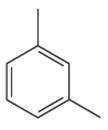
In this aromatic compound, the benzene ring has two methyl groups attached. The alkyl groups are electron donating inductively, thus increases the electron density around the ring and activates it. As the ring is electron rich and activated it can undergo Friedel–Crafts reaction.
It is determined that a given compound can undergo Friedel–Crafts reaction based on the activation of aromatic ring.
(b)
Interpretation:
Whether the given compound can undergo a Friedel–Crafts reaction, it is to be determined.
Concept introduction:
The Friedel–Crafts reaction is the electrophilic aromatic substitution reaction. In The Friedel–Crafts alkylation, the aromatic compound reacts with alkyl halide in presence of
Answer to Problem 23.51P
The given compound cannot undergo a Friedel–Crafts reaction as the aromatic ring is deactivated by two acetyl groups.
Explanation of Solution
The given aromatic compound is:
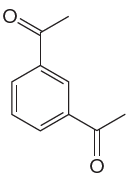
In this aromatic compound, the benzene ring has two acetyl (carbonyl) groups attached. The carbonyl groups have electron withdrawing resonance effect, thus decreases the electron density around the ring and deactivates it. As the ring is electron poor and deactivated it cannot undergo Friedel–Crafts reaction.
It is determined that a given compound cannot undergo Friedel–Crafts reaction based on the deactivation of aromatic ring.
(c)
Interpretation:
Whether the given compound can undergo a Friedel–Crafts reaction, it is to be determined.
Concept introduction:
The Friedel–Crafts reaction is the electrophilic aromatic substitution reaction. In The Friedel–Crafts alkylation, the aromatic compound reacts with alkyl halide in presence of
Answer to Problem 23.51P
The given compound cannot undergo a Friedel–Crafts reaction as the aromatic ring is deactivated by nitrile groups.
Explanation of Solution
The given aromatic compound is:
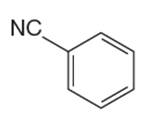
In this aromatic compound, the benzene ring has nitrile group attached. The nitrile group have electron withdrawing resonance effect, thus decreases the electron density around the ring and deactivates it. As the ring is electron poor and deactivated it cannot undergo Friedel–Crafts reaction.
It is determined that a given compound cannot undergo Friedel–Crafts reaction based on the deactivation of aromatic ring.
(d)
Interpretation:
Whether the given compound can undergo a Friedel–Crafts reaction, it is to be determined.
Concept introduction:
The Friedel–Crafts reaction is the electrophilic aromatic substitution reaction. In The Friedel–Crafts alkylation, the aromatic compound reacts with alkyl halide in presence of
Answer to Problem 23.51P
The given compound cannot undergo a Friedel–Crafts reaction as the aromatic ring is deactivated by
Explanation of Solution
The given aromatic compound is:

In this aromatic compound, the benzene ring has
It is determined that a given compound cannot undergo Friedel–Crafts reaction based on the deactivation of aromatic ring.
(e)
Interpretation:
Whether the given compound can undergo a Friedel–Crafts reaction, it is to be determined.
Concept introduction:
The Friedel–Crafts reaction is the electrophilic aromatic substitution reaction. In The Friedel–Crafts alkylation, the aromatic compound reacts with alkyl halide in presence of
Answer to Problem 23.51P
The given compound cannot undergo a Friedel–Crafts reaction as the aromatic ring is deactivated by
Explanation of Solution
The given aromatic compound is:
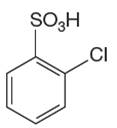
In this aromatic compound, the benzene ring has
It is determined that a given compound cannot undergo Friedel–Crafts reaction based on the deactivation of aromatic ring.
(f)
Interpretation:
Whether the given compound can undergo a Friedel–Crafts reaction, it is to be determined.
Concept introduction:
The Friedel–Crafts reaction is the electrophilic aromatic substitution reaction. In The Friedel–Crafts alkylation, the aromatic compound reacts with alkyl halide in presence of
Answer to Problem 23.51P
The given compound can undergo a Friedel–Crafts reaction as the aromatic ring is activated by one methyl and one methoxy groups.
Explanation of Solution
The given aromatic compound is:
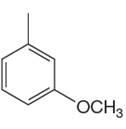
In this aromatic compound, the benzene ring has one methyl and one methoxy groups attached. The alkyl groups are electron donating inductively and methoxy group has electron donating resonance effect, thus increases the electron density around the ring and activates it. As the ring is electron rich and activated it can undergo Friedel–Crafts reaction.
It is determined that a given compound can undergo Friedel–Crafts reaction based on the activation of aromatic ring.
Want to see more full solutions like this?
Chapter 23 Solutions
EBK GET READY FOR ORGANIC CHEMISTRY
- In the phase diagram of steel (two components Fe and C), region A is the gamma austenite solid and region B contains the gamma solid and liquid. Indicate the degrees of freedom that the fields A and B have,arrow_forwardFor a condensed binary system in equilibrium at constant pressure, indicate the maximum number of phases that can exist.arrow_forwardPart V. Label ad match the carbons in compounds Jane and Diane w/ the corresponding peak no. in the Spectra (Note: use the given peak no. To label the carbons, other peak no are intentionally omitted) 7 4 2 -0.13 -0.12 -0.11 -0.10 -0.08 8 CI Jane 1 -0.09 5 210 200 190 180 170 160 150 140 130 120 110 100 -8 90 f1 (ppm) 11 8 172.4 172.0 f1 (ppr HO CI NH Diane 7 3 11 80 80 -80 -R 70 60 60 2 5 -8 50 40 8. 170 160 150 140 130 120 110 100 90 -0 80 70 20 f1 (ppm) 15 30 -20 20 -60 60 -0.07 -0.06 -0.05 -0.04 -0.03 -0.02 -0.01 -0.00 -0.01 10 -0.17 16 15 56 16 -0.16 -0.15 -0.14 -0.13 -0.12 -0.11 -0.10 -0.09 -0.08 -0.07 -0.06 -0.05 -0.04 17.8 17.6 17.4 17.2 17.0 f1 (ppm) -0.03 -0.02 550 106 40 30 20 20 -0.01 -0.00 F-0.01 10 0arrow_forward
- n Feb 3 A T + 4. (2 pts) Draw the structure of the major component of the Limonene isolated. Explain how you confirmed the structure. 5. (2 pts) Draw the fragment corresponding to the base peak in the Mass spectrum of Limonene. 6. (1 pts) Predict the 1H NMR spectral data of R-Limonene. Proton NMR: 5.3 pon multiplet (H Ringarrow_forwardPart VI. Ca H 10 O is the molecular formula of compound Tom and gives the in the table below. Give a possible structure for compound Tom. 13C Signals summarized C1 C2 C3 C4 C5 C6 C7 13C shift (ppm) 23.5 27.0 33.0 35.8 127 162 205 DEPT-90 + DEPT-135 + +arrow_forward2. Using the following data to calculate the value of AvapH o of water at 298K. AvapH o of water at 373K is 40.7 kJ/mol; molar heat capacity of liquid water at constant pressure is 75.2J mol-1 K-1 and molar heat capacity of water vapor at constant pressure is 33.6 J mol-1 K-1.arrow_forward
- Part VII. Below are the 'HNMR 13 3 C-NMR, COSY 2D- NMR, and HSQC 20-NMR (Similar with HETCOR but axes are reversed) spectra of an organic compound with molecular formula C6H13 O. Assign chemical shift values to the H and c atoms of the compound. Find the structure. Show complete solutions. Predicted 1H NMR Spectrum ли 4.7 4.6 4.5 4.4 4.3 4.2 4.1 4.0 3.9 3.8 3.7 3.6 3.5 3.4 3.3 3.2 3.1 3.0 2.9 2.8 2.7 2.6 2.5 2.4 2.3 2.2 2.1 2.0 1.9 1.8 1.7 1.6 1.5 1.4 1.3 1.2 1.1 1.0 0.9 0.8 f1 (ppm)arrow_forward3. Draw the expanded structural formula, the condensed structural formula, and the skeletal structural formula for 2-pentene. expanded structure: Condensed structure: Skeletal formula: 4. Draw the expanded structural formula, the condensed structural formula, and the skeletal structural formula for 2-methyl-3-heptene. expanded structure: Condensed structure: Skeletal formula: following structurearrow_forwardPart IV. Propose a plausible Structure w/ the following descriptions: a) A 5-carbon hydrocarbon w/ a single peak in its proton decoupled the DEPT-135 Spectrum shows a negative peak C-NMR spectrum where b) what cyclohexane dione isomer gives the largest no. Of 13C NMR signals? c) C5H120 (5-carbon alcohol) w/ most deshielded carbon absent in any of its DEPT Spectivaarrow_forward
 ChemistryChemistryISBN:9781305957404Author:Steven S. Zumdahl, Susan A. Zumdahl, Donald J. DeCostePublisher:Cengage Learning
ChemistryChemistryISBN:9781305957404Author:Steven S. Zumdahl, Susan A. Zumdahl, Donald J. DeCostePublisher:Cengage Learning ChemistryChemistryISBN:9781259911156Author:Raymond Chang Dr., Jason Overby ProfessorPublisher:McGraw-Hill Education
ChemistryChemistryISBN:9781259911156Author:Raymond Chang Dr., Jason Overby ProfessorPublisher:McGraw-Hill Education Principles of Instrumental AnalysisChemistryISBN:9781305577213Author:Douglas A. Skoog, F. James Holler, Stanley R. CrouchPublisher:Cengage Learning
Principles of Instrumental AnalysisChemistryISBN:9781305577213Author:Douglas A. Skoog, F. James Holler, Stanley R. CrouchPublisher:Cengage Learning Organic ChemistryChemistryISBN:9780078021558Author:Janice Gorzynski Smith Dr.Publisher:McGraw-Hill Education
Organic ChemistryChemistryISBN:9780078021558Author:Janice Gorzynski Smith Dr.Publisher:McGraw-Hill Education Chemistry: Principles and ReactionsChemistryISBN:9781305079373Author:William L. Masterton, Cecile N. HurleyPublisher:Cengage Learning
Chemistry: Principles and ReactionsChemistryISBN:9781305079373Author:William L. Masterton, Cecile N. HurleyPublisher:Cengage Learning Elementary Principles of Chemical Processes, Bind...ChemistryISBN:9781118431221Author:Richard M. Felder, Ronald W. Rousseau, Lisa G. BullardPublisher:WILEY
Elementary Principles of Chemical Processes, Bind...ChemistryISBN:9781118431221Author:Richard M. Felder, Ronald W. Rousseau, Lisa G. BullardPublisher:WILEY





